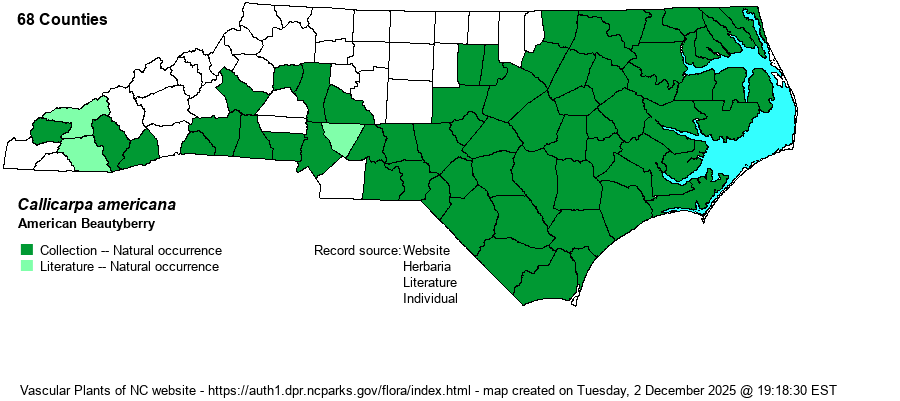| Author | L. | |
| Distribution | Throughout the Coastal Plain, and in the southeastern half of the Piedmont. Scattered at a few areas in the west-central Piedmont and in the southern Mountains. Absent from most of the Mountains, at least the northern counties, as well as the northwestern portions of the Piedmont. The many new county records on iNaturalist could well represent planted individuals, and this website is thus not used in any county mapping.
This Southern species ranges north only to southeastern VA and southern MO. It ranges south to the Gulf of Mexico, to southern TX.
| |
| Abundance | Frequent to common over nearly all of the Coastal Plain. Infrequent to fairly common along the southeastern edge of the Piedmont, but uncommon over most of the southwestern portion of that province. Rare in the southern Mountains. In some places in the Piedmont it might not be native, as the species does escape from cultivation. | |
| Habitat | The species favors somewhat moist sandy soil of pinewoods (often in Loblolly Pine [Pinus taeda] stands), pine/scrub oak sandhills, maritime forests, and maritime thickets. In some places it is found in somewhat rocky forests. | |
| Phenology | It blooms in June and July; it fruits from August to October, and fruit are often visible into the winter. | |
| Identification | This is a deciduous shrub that grows to about 5-6 feet tall, often with long branches and thus frequently is wider than tall. The leaves are opposite and are fairly large, being elliptic with fairly large teeth; leaves average about 4-5 inches long. In each leaf axil grows a dense cluster of small pink flowers, followed by unique (for our region) shiny magenta-purple berries, growing in a dense ball-like cluster. So, if the opposite and strongly toothed leaves aren’t good enough for identification (and they should), the dense axillary clusters of purple fruit or pink flowers will clinch the identification. After the leaves fall, the naked branches may still retain the ball-like clusters of purple berries into late fall or early winter. The non-native C. dichotoma has smaller and narrower leaves that are much more crowded on the branches than in the native species. | |
| Taxonomic Comments | None
| |
| Other Common Name(s) | French-mulberry is another frequently used name. Often simply just called Beautyberry, but there are several exotic Callicarpa species in our area – named as Chinese Beautyberry (C. dichotoma) and Japanese Beautyberry (C. japonica) – and thus the American modifier is usually in use for the distinction. | |
| State Rank | S5 | |
| Global Rank | G5 | |
| State Status | | |
| US Status | | |
| USACE-agcp | FACU link |
| USACE-emp | FACU link |

